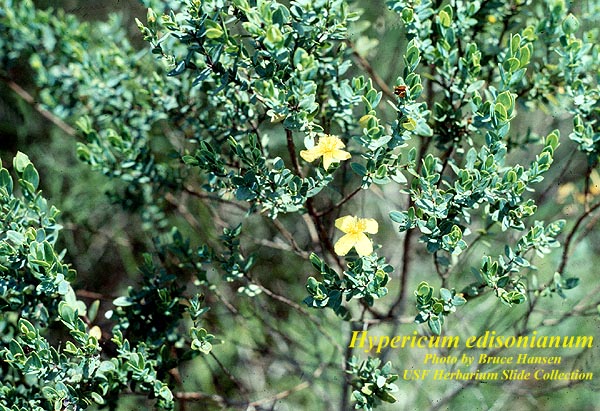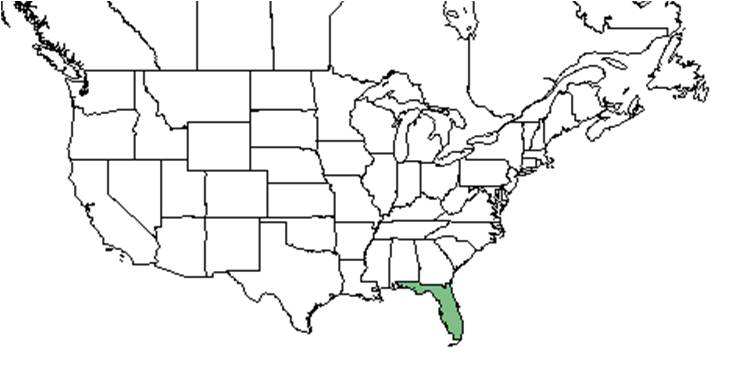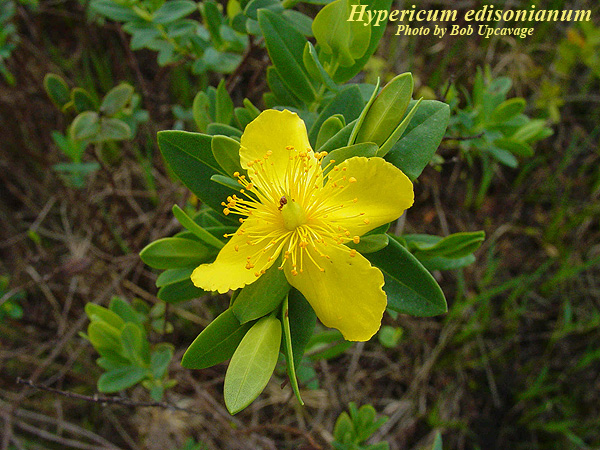Difference between revisions of "Hypericum edisonianum"
HaleighJoM (talk | contribs) (→Ecology) |
|||
| (40 intermediate revisions by 6 users not shown) | |||
| Line 3: | Line 3: | ||
{{taxobox | {{taxobox | ||
| name = Hypericum edisonianum | | name = Hypericum edisonianum | ||
| − | | image = | + | | image = Hype edis6.jpg |
| − | | image_caption = | + | | image_caption = Photo by Bruce Hansen, [http://www.florida.plantatlas.usf.edu/Default.aspx Atlas of Florida Vascular Plants] |
| regnum = Plantae | | regnum = Plantae | ||
| divisio = Magnoliophyta - Flowering plants | | divisio = Magnoliophyta - Flowering plants | ||
| Line 15: | Line 15: | ||
| binomial_authority = (Small) P. Adams & N. Robson | | binomial_authority = (Small) P. Adams & N. Robson | ||
| range_map = hype_edis_dist.jpg | | range_map = hype_edis_dist.jpg | ||
| − | | range_map_caption = Natural range of ''Hypericum edisonianum'' from USDA NRCS [http:// | + | | range_map_caption = Natural range of ''Hypericum edisonianum'' from USDA NRCS [http://plants.usda.gov/core/profile?symbol=HYED Plants Database]. |
}} | }} | ||
Common name: Arcadian St. Johnswort | Common name: Arcadian St. Johnswort | ||
| + | ==Taxonomic notes== | ||
| + | Synonym: Ascyrum edisonianum Small [http://plants.usda.gov/core/profile?symbol=HYED USDA NRCS Plants Database] | ||
==Description== | ==Description== | ||
<!-- Basic life history facts such as annual/perrenial, monoecious/dioecious, root morphology, seed type, etc. --> | <!-- Basic life history facts such as annual/perrenial, monoecious/dioecious, root morphology, seed type, etc. --> | ||
| + | ''H. edisonianum'' is a multi-branched evergreen shrub that forms extensive thickets. The stems are thin and dark with silvery black bark, and are leafless except for the upper branches. Leaves are opposite, oval, and have abaxial glands. The flowers are composed of 4 yellow petals, 2 large sepals with pointed tips and rounded bases.<ref name="FNAI">[[http://www.fnai.org/FieldGuide/pdf/Hypericum_edisonianum.pdf]]FNAI. Accessed: January 5, 2015</ref> | ||
| + | |||
| + | This species exhibits traits that are common to rare and geographically limited plant species such as: (a) heavy reliance on clonal propagation to maintain local stands (b) passive seed dispersal resulting in a near-parent seed shadow (c) limited numbers of genetically unique individuals in isolated seasonal pond habitat (d) self-incompatibility.<ref name="Abrahamson and Vander Kloet 2014">Warren G. Abrahamson II and Sam P. Vander Kloet. "The Reproduction and Ecology of Hypericum edisonianum: An Endangered Florida Endemic" Castanea 79.3 (2014): 168-181. Available at: http://works.bepress.com/warren_abrahamson/153</ref> | ||
| + | |||
| + | “Usually glabrous herbs or shrubs. Leaves usually punctate, simple, opposite, entire, usually sessile or subsessile, exstipulate. Inflorescence basically cymose; flowers perfect, regular, bracteates, subsessile or short-pedicellate, sepals 2, 4, or 5, persistent; petals 4 or 5, usually marcescent, yellow or pink; stamens 5-numerous, separate or connate basally forming 3-5 clusters or fascicles, filaments usually persistent; carpels 2-5, stigmas and styles separate or fused, ovary superior, 1-locular or partly or wholly 2-5 locular, placentation axile or parietal. Capsules basically ovoid, longitudinally dehiscent, styles usually persistent; seeds numerous, lustrous, areolate, cylindric or oblong. In general our species form a polymorphic complex with many intergrading taxa.” <ref name="Radford et al 1964">Radford, Albert E., Harry E. Ahles, and C. Ritchie Bell. Manual of the Vascular Flora of the Carolinas. 1964, 1968. The University of North Carolina Press. 709. Print.</ref> | ||
==Distribution== | ==Distribution== | ||
| + | The range is limited to the scrubs of the central peninsular Florida in Highlands, Polk, Glades, DeSoto, and Collier counties. <ref name="Abrahamson and Vander Kloet 2014"/> Excessive drainage, agriculture, and urban development are locally eliminating the species. <ref name="Ward 1979">Ward, D.B. 1979. Rare and endangered biota of Florida, Volume 5. Plants. University Presses of Florida, Gainesville, Florida.</ref> | ||
| + | |||
==Ecology== | ==Ecology== | ||
===Habitat=== <!--Natural communities, human disturbed habitats, topography, hydrology, soils, light, fire regime requirements for removal of competition, etc.--> | ===Habitat=== <!--Natural communities, human disturbed habitats, topography, hydrology, soils, light, fire regime requirements for removal of competition, etc.--> | ||
| + | In the central peninsular counties of Florida, ''H. edisonianum'' has been found in ephemeral ponds, flatwood ponds, and wet swales in low pine-palmetto flats, cutthroat grass seeps, and along lake margins. <ref name="Abrahamson and Vander Kloet 2014"/><ref name="FSU Herbarium">Florida State University Robert K. Godfrey Herbarium database. URL: [http://herbarium.bio.fsu.edu http://herbarium.bio.fsu.edu]. Last accessed: October 2015. Collectors: W.P. Adams, Leonard J. Brass, Edwin L. Bridges, George R. Cooley, R.K. Godfrey, Colleen Hoy, Beverly Judd, Walter S. Judd, Steve L. Orzell, Grady W. Reinert, Joe Testasecca, Daniel B. Ward, Kenneth A. Wilson, Carroll E. Wood. States and Counties: Florida: Glades, Highlands. Compiled by Tall Timbers Research Station and Land Conservancy.</ref> It tends to form dense thickets of ramets in poorly drained sandy sites that have a low pH, little organic matter, and low nutrient status, such as seasonal ponds. <ref name="Abrahamson and Vander Kloet 2014"/> Associated species include ''Andropogon brachystachyus, Ascyrum tetrapetalum'', and ''Ascyrum hypericoides''. Soils have been recorded as Paola-Basinger (Spodic Quartzipsamments). <ref name="FSU Herbarium"/> | ||
| + | |||
===Phenology=== <!--Timing off flowering, fruiting, seed dispersal, and environmental triggers. Cite PanFlora website if appropriate: http://www.gilnelson.com/PanFlora/ --> | ===Phenology=== <!--Timing off flowering, fruiting, seed dispersal, and environmental triggers. Cite PanFlora website if appropriate: http://www.gilnelson.com/PanFlora/ --> | ||
| + | ''H. edisonianum'' is self-incompatible. The amount of flowers in anthesis within ramets are limited and independent of one another because individual flowers are short lived and flowering occurs throughout the year. Reproduces by seeds and clonal sprouting from underground rhizomes which is important for demography and genetic structure of populations. <ref name="Abrahamson and Vander Kloet 2014"/> | ||
| + | |||
===Seed dispersal=== | ===Seed dispersal=== | ||
| − | ===Seed bank and germination=== | + | Seeds are a dark brown, pointed capsule<ref name="FNAI"/>. It exhibits passive seed dispersal resulting in a near-parent seed shadow. In wet areas, seeds sink and become embedded in sand near the parent unless moved by sheetflow during flooding or by wind during dry periods. <ref name="Abrahamson and Vander Kloet 2014"/> |
| + | <!--===Seed bank and germination===--> | ||
===Fire ecology=== <!--Fire tolerance, fire dependence, adaptive fire responses--> | ===Fire ecology=== <!--Fire tolerance, fire dependence, adaptive fire responses--> | ||
| + | ''H. edisonianum'' is found in pyrogenic scrubs of central peninsular Florida and rapidly regenerates ramets following fires (Abrahamson et al. 1984; Menges and Kohfeldt 1995). Fires and other disturbances can reduce competition and the effects of herbivory and diseases. <ref name="Abrahamson and Vander Kloet 2014"/> | ||
| + | |||
===Pollination=== | ===Pollination=== | ||
| − | + | Various pollinators were observed to visit flowers of ''Hypericum edisonianum'' at the Archbold Biological Station. These include long-tongued bees from the Apidae family (''Apis mellifera, Bombus impatiens'' and ''B. pennsylvanicus''), plasterer bees from the Colletidae family (''Hylaeus confluens'' and ''H. schwarzi''), sweat bees from the Halictidae family (''Augochloropsis sumptuosa, Lasioglossum miniatulus, L. nymphalis, L. pectoralis, L. placidensis'' and ''L. puteulanum'') and leafcutting bees from the Megachilidae family (''Anthidiellum perplexum, Megachile brevis pseudobrevis, M. mendica'' and ''M. petulans'').<ref name="Deyrup 2015">Deyrup, M.A. and N.D. 2015. Database of observations of Hymenoptera visitations to flowers of plants on Archbold Biological Station, Florida, USA.</ref> | |
| + | <!--===Herbivory and toxicology===--> | ||
| + | <!--===Diseases and parasites===--> | ||
| − | + | ==Conservation, cultivation, and restoration== | |
| + | It is unable to withstand excessive landscape drainage, agricultural and human development. <ref name="Abrahamson and Vander Kloet 2014"/> Fire suppression can result in population loss. Allowing prescribed fires to burn into wetlands and maintaining the natural hydrology of flatwoods can help manage populations of ''H. edisonianum''. Listed as G2/S2.<ref name="FNAI"/> | ||
| − | + | ==Cultural use== | |
| − | |||
| − | |||
| − | |||
| − | |||
| − | |||
| − | == | ||
| − | |||
| − | |||
| − | |||
==Photo Gallery== | ==Photo Gallery== | ||
| + | <gallery widths=180px> | ||
| + | File: Hype_edis4BUp.jpg | <center> Flowers of ''Hypericum'' ''edisonianum'' <p> Photo by Bob Upcavage, [http://www.florida.plantatlas.usf.edu/Default.aspx Atlas of Florida Vascular Plants] </p> | ||
| + | </gallery> | ||
==References and notes== | ==References and notes== | ||
| − | + | Abrahamson, W. G. (1984). "Species Responses to Fire on the Florida Lake Wales Ridge." American Journal of Botany 71(1): 35-43. | |
| + | |||
| + | Menges, E.S. and N. Kohfeldt. 1995. Life history strategies of Florida scrub plants in relation to fire. Bull. Torrey Bot. Club 122:282–297. | ||
Latest revision as of 19:35, 1 July 2022
| Hypericum edisonianum | |
|---|---|

| |
| Photo by Bruce Hansen, Atlas of Florida Vascular Plants | |
| Scientific classification | |
| Kingdom: | Plantae |
| Division: | Magnoliophyta - Flowering plants |
| Class: | Magnoliopsida - Dicotyledons |
| Order: | Theales |
| Family: | Clusiaceae ⁄ Guttiferae |
| Genus: | Hypericum |
| Species: | H. edisonianum |
| Binomial name | |
| Hypericum edisonianum (Small) P. Adams & N. Robson | |

| |
| Natural range of Hypericum edisonianum from USDA NRCS Plants Database. | |
Common name: Arcadian St. Johnswort
Contents
Taxonomic notes
Synonym: Ascyrum edisonianum Small USDA NRCS Plants Database
Description
H. edisonianum is a multi-branched evergreen shrub that forms extensive thickets. The stems are thin and dark with silvery black bark, and are leafless except for the upper branches. Leaves are opposite, oval, and have abaxial glands. The flowers are composed of 4 yellow petals, 2 large sepals with pointed tips and rounded bases.[1]
This species exhibits traits that are common to rare and geographically limited plant species such as: (a) heavy reliance on clonal propagation to maintain local stands (b) passive seed dispersal resulting in a near-parent seed shadow (c) limited numbers of genetically unique individuals in isolated seasonal pond habitat (d) self-incompatibility.[2]
“Usually glabrous herbs or shrubs. Leaves usually punctate, simple, opposite, entire, usually sessile or subsessile, exstipulate. Inflorescence basically cymose; flowers perfect, regular, bracteates, subsessile or short-pedicellate, sepals 2, 4, or 5, persistent; petals 4 or 5, usually marcescent, yellow or pink; stamens 5-numerous, separate or connate basally forming 3-5 clusters or fascicles, filaments usually persistent; carpels 2-5, stigmas and styles separate or fused, ovary superior, 1-locular or partly or wholly 2-5 locular, placentation axile or parietal. Capsules basically ovoid, longitudinally dehiscent, styles usually persistent; seeds numerous, lustrous, areolate, cylindric or oblong. In general our species form a polymorphic complex with many intergrading taxa.” [3]
Distribution
The range is limited to the scrubs of the central peninsular Florida in Highlands, Polk, Glades, DeSoto, and Collier counties. [2] Excessive drainage, agriculture, and urban development are locally eliminating the species. [4]
Ecology
Habitat
In the central peninsular counties of Florida, H. edisonianum has been found in ephemeral ponds, flatwood ponds, and wet swales in low pine-palmetto flats, cutthroat grass seeps, and along lake margins. [2][5] It tends to form dense thickets of ramets in poorly drained sandy sites that have a low pH, little organic matter, and low nutrient status, such as seasonal ponds. [2] Associated species include Andropogon brachystachyus, Ascyrum tetrapetalum, and Ascyrum hypericoides. Soils have been recorded as Paola-Basinger (Spodic Quartzipsamments). [5]
Phenology
H. edisonianum is self-incompatible. The amount of flowers in anthesis within ramets are limited and independent of one another because individual flowers are short lived and flowering occurs throughout the year. Reproduces by seeds and clonal sprouting from underground rhizomes which is important for demography and genetic structure of populations. [2]
Seed dispersal
Seeds are a dark brown, pointed capsule[1]. It exhibits passive seed dispersal resulting in a near-parent seed shadow. In wet areas, seeds sink and become embedded in sand near the parent unless moved by sheetflow during flooding or by wind during dry periods. [2]
Fire ecology
H. edisonianum is found in pyrogenic scrubs of central peninsular Florida and rapidly regenerates ramets following fires (Abrahamson et al. 1984; Menges and Kohfeldt 1995). Fires and other disturbances can reduce competition and the effects of herbivory and diseases. [2]
Pollination
Various pollinators were observed to visit flowers of Hypericum edisonianum at the Archbold Biological Station. These include long-tongued bees from the Apidae family (Apis mellifera, Bombus impatiens and B. pennsylvanicus), plasterer bees from the Colletidae family (Hylaeus confluens and H. schwarzi), sweat bees from the Halictidae family (Augochloropsis sumptuosa, Lasioglossum miniatulus, L. nymphalis, L. pectoralis, L. placidensis and L. puteulanum) and leafcutting bees from the Megachilidae family (Anthidiellum perplexum, Megachile brevis pseudobrevis, M. mendica and M. petulans).[6]
Conservation, cultivation, and restoration
It is unable to withstand excessive landscape drainage, agricultural and human development. [2] Fire suppression can result in population loss. Allowing prescribed fires to burn into wetlands and maintaining the natural hydrology of flatwoods can help manage populations of H. edisonianum. Listed as G2/S2.[1]
Cultural use
Photo Gallery
Flowers of Hypericum edisonianum Photo by Bob Upcavage, Atlas of Florida Vascular Plants
References and notes
Abrahamson, W. G. (1984). "Species Responses to Fire on the Florida Lake Wales Ridge." American Journal of Botany 71(1): 35-43.
Menges, E.S. and N. Kohfeldt. 1995. Life history strategies of Florida scrub plants in relation to fire. Bull. Torrey Bot. Club 122:282–297.
- ↑ 1.0 1.1 1.2 [[1]]FNAI. Accessed: January 5, 2015
- ↑ 2.0 2.1 2.2 2.3 2.4 2.5 2.6 2.7 Warren G. Abrahamson II and Sam P. Vander Kloet. "The Reproduction and Ecology of Hypericum edisonianum: An Endangered Florida Endemic" Castanea 79.3 (2014): 168-181. Available at: http://works.bepress.com/warren_abrahamson/153
- ↑ Radford, Albert E., Harry E. Ahles, and C. Ritchie Bell. Manual of the Vascular Flora of the Carolinas. 1964, 1968. The University of North Carolina Press. 709. Print.
- ↑ Ward, D.B. 1979. Rare and endangered biota of Florida, Volume 5. Plants. University Presses of Florida, Gainesville, Florida.
- ↑ 5.0 5.1 Florida State University Robert K. Godfrey Herbarium database. URL: http://herbarium.bio.fsu.edu. Last accessed: October 2015. Collectors: W.P. Adams, Leonard J. Brass, Edwin L. Bridges, George R. Cooley, R.K. Godfrey, Colleen Hoy, Beverly Judd, Walter S. Judd, Steve L. Orzell, Grady W. Reinert, Joe Testasecca, Daniel B. Ward, Kenneth A. Wilson, Carroll E. Wood. States and Counties: Florida: Glades, Highlands. Compiled by Tall Timbers Research Station and Land Conservancy.
- ↑ Deyrup, M.A. and N.D. 2015. Database of observations of Hymenoptera visitations to flowers of plants on Archbold Biological Station, Florida, USA.
